Overview
Navigating the world of logo and brand design can feel overwhelming for startup founders. You might find yourself grappling with how to effectively convey your brand's identity amidst the noise of competition. This struggle can lead to feelings of uncertainty and frustration, especially when you know how vital a strong brand presence is in today’s market.
However, there is hope. The article outlines five key steps to help you master logo and brand design for your startup. These steps include:
- Defining your brand identity
- Gathering inspiration
- Choosing logo styles
- Selecting colors and typography
- Refining your logo for launch
Each step is not just a checklist; it’s a nurturing process that emphasizes the importance of aligning your design choices with your startup's mission and values.
As you embark on this journey, remember to incorporate feedback from your team and potential customers. This collaborative approach not only enhances your design but also fosters a sense of community around your brand. Maintaining consistency throughout your branding efforts will significantly enhance brand recognition and customer loyalty, making your startup stand out in a crowded marketplace.
By following these steps, you can transform the daunting task of logo and brand design into a fulfilling experience that resonates with your audience. Embrace this opportunity to express your unique vision and connect with your customers on a deeper level.
Introduction
Crafting a compelling logo and brand identity is a crucial step for any startup seeking to find its unique voice in a bustling market. It’s concerning to note that while 95% of companies have brand guidelines, only 25% actively put them into practice. This gap highlights the pressing challenge of establishing a clear and impactful identity.
In this article, we will explore five essential steps that empower entrepreneurs to master logo and brand design. These insights can transform your vision into a recognizable and trusted brand.
How can startups navigate the complexities of design to ensure their identity resonates with their audience while standing out in such a competitive landscape? Together, we can find the answers.
Define Your Brand Identity
Establishing your identity can be daunting, especially when you face crucial inquiries about your business:
- What is your mission?
- What values do you uphold?
- Who is your target audience?
Creating a persona that embodies these elements is essential; it should reflect the character and tone of your identity. This persona will guide all your creative decisions. To deepen your understanding, consider conducting surveys or interviews with potential customers. Gathering insights into their perceptions and expectations can be invaluable. Recording these findings will help you develop a comprehensive logo style manual, which is crucial for influencing .
It's significant to note that while 95% of companies possess guidelines for their image, only 25% actively implement them. This highlights the importance of having a clearly defined corporate persona. Moreover, startups that clarify their image before launching are more likely to establish a strong market presence. Effective marketing can boost revenue by 10-20%, a powerful incentive for any founder. Successful examples of logo development, such as Nike's 'Just Do It' campaign, illustrate how storytelling can forge emotional connections with consumers, leading to increased loyalty and engagement.
At RNO1, we are here to empower you. , including our collaboration with Microsoft and the successes of clients like RentMethod and MetraTech, are testaments to our commitment to your journey. Our dedication to logo and brand design-focused solutions means that every element of your corporate image will be crafted with precision. We aim to enhance your marketability through our Return On Design & Digital (RODD) strategies, ensuring you feel supported every step of the way.
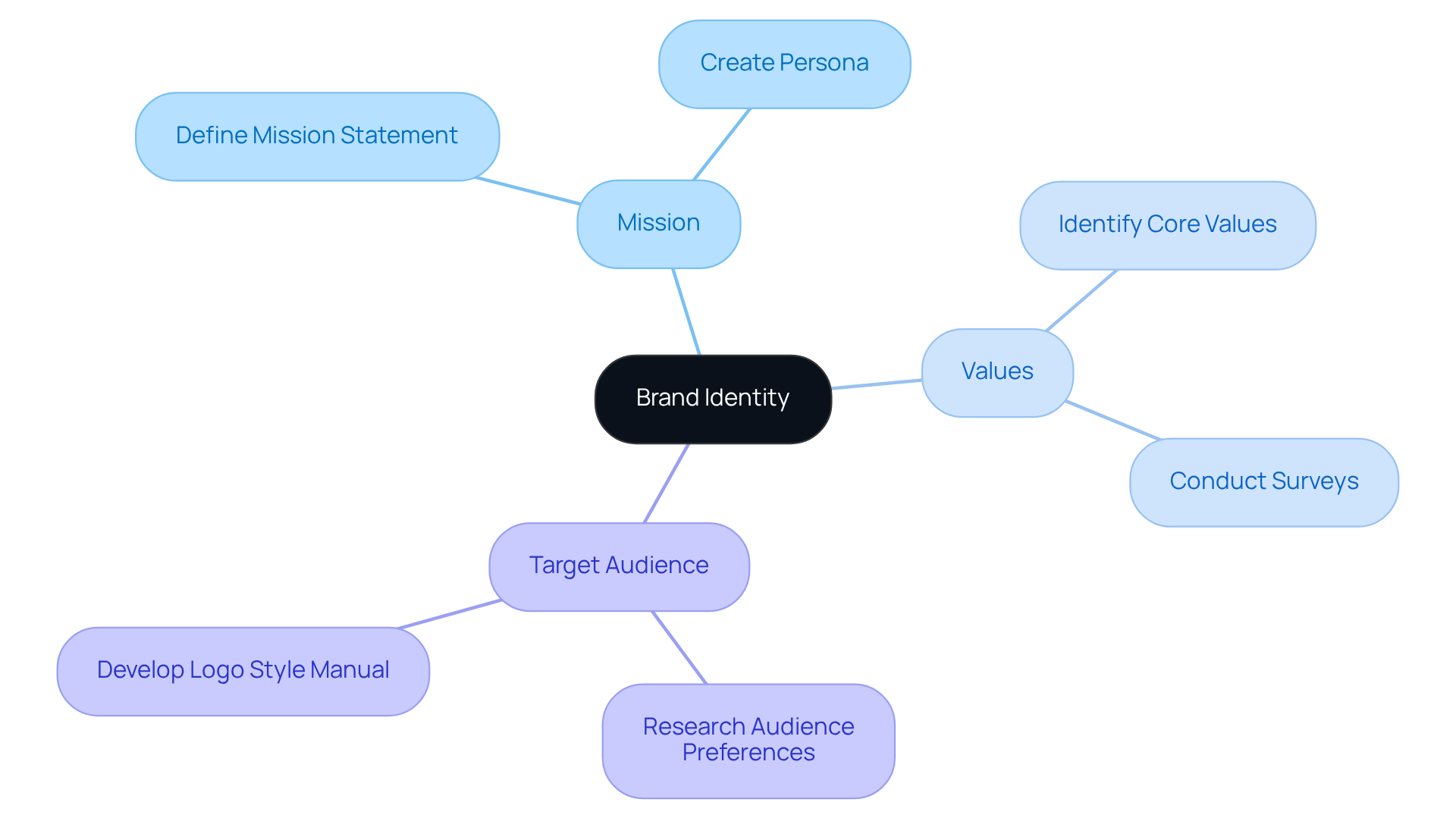
Gather Inspiration and Brainstorm Ideas
Many tech startup founders struggle with finding the right sources of inspiration for their design projects. It can feel overwhelming to sift through countless ideas and styles, leaving you unsure of how to create a cohesive vision. This uncertainty can lead to frustration and hinder the creative process. However, by exploring various sources of inspiration—such as:
- Creative websites
- Social media platforms like Pinterest and Instagram
- The beauty of nature or architecture
you can begin to find clarity.
Creating a mood board can be a transformative step in this journey. It’s more than just a visual collection; it’s a powerful tool that enhances communication and clarifies your project objectives. By incorporating colors, fonts, and symbols that resonate with your brand identity and RNO1's logo and brand design strategies, you establish a solid foundation for your design. Remember, 70% of consumers prefer symbols that represent inclusivity and diversity, so it’s essential to choose elements thoughtfully.
Engaging in brainstorming sessions with your team or peers can also foster a nurturing environment where ideas flow freely without judgment. Techniques like mind mapping or sketching can help , stimulating creativity. Research indicates that mood boards can trigger a 'flow state' in designers, paving the way for innovative ideas to emerge. Aim to generate a broad range of concepts before narrowing them down to a few promising directions. A well-crafted mood board not only serves as a design foundation but also strengthens client relationships by aligning expectations and enhancing trust. By sharing this process, you invite collaboration and connection, creating a supportive community around your vision.
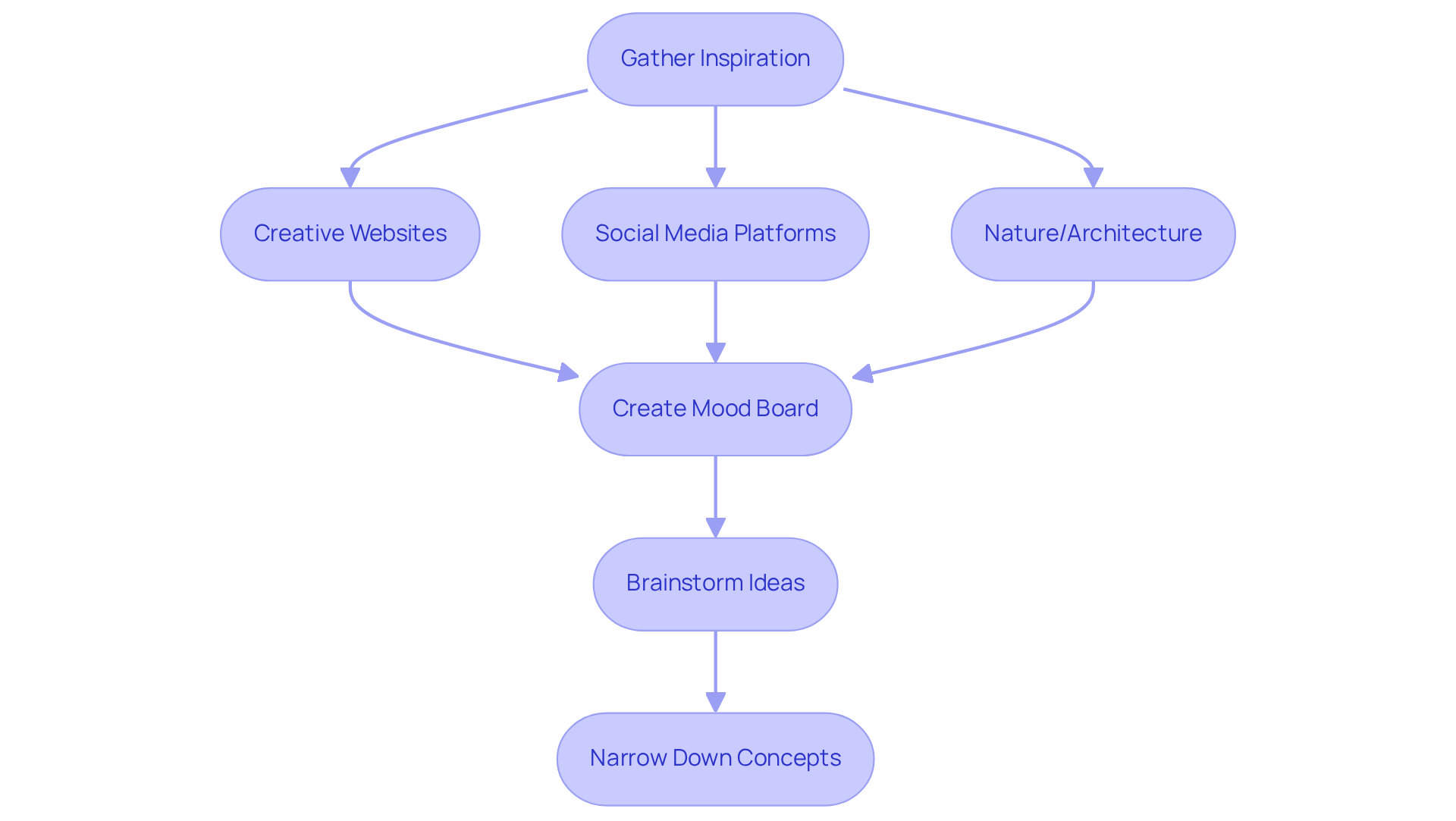
Choose Your Logo Style and Type
Choosing a logo and brand design for your startup can feel overwhelming, especially with so many options available:
- Wordmarks (text-based)
- Lettermarks (initials)
- Pictorial marks (icons)
- Abstract designs
- Combination marks
Each style in logo and brand design serves a unique purpose and can significantly influence how your company is perceived. For technology firms, contemporary and abstract designs often communicate innovation and forward-thinking, appealing to younger consumers who value creativity and inclusivity. On the other hand, traditional businesses may find that a classic wordmark resonates more deeply with their audience.
Current trends indicate that minimalist aesthetics are favored in the tech sector, with many companies opting for clean lines and simple forms that enhance recognition and memorability. It's important to note that studies suggest symbols with effective color application can boost product recognition by as much as 80%. This makes color selection a vital part of your creative process. To ensure your logo and brand design align with your company's image, consider sketching out several concepts across various styles and gathering feedback from your target audience. This iterative approach not only helps you determine which concept resonates most but also strengthens your visibility and connection with consumers.
Remember, this journey is about more than just aesthetics; it's about creating a visual identity through logo and brand design that reflects your values and mission. You're not alone in this process, and by reaching out to others and sharing your experiences, you can find the you need to make the best choice for your startup.
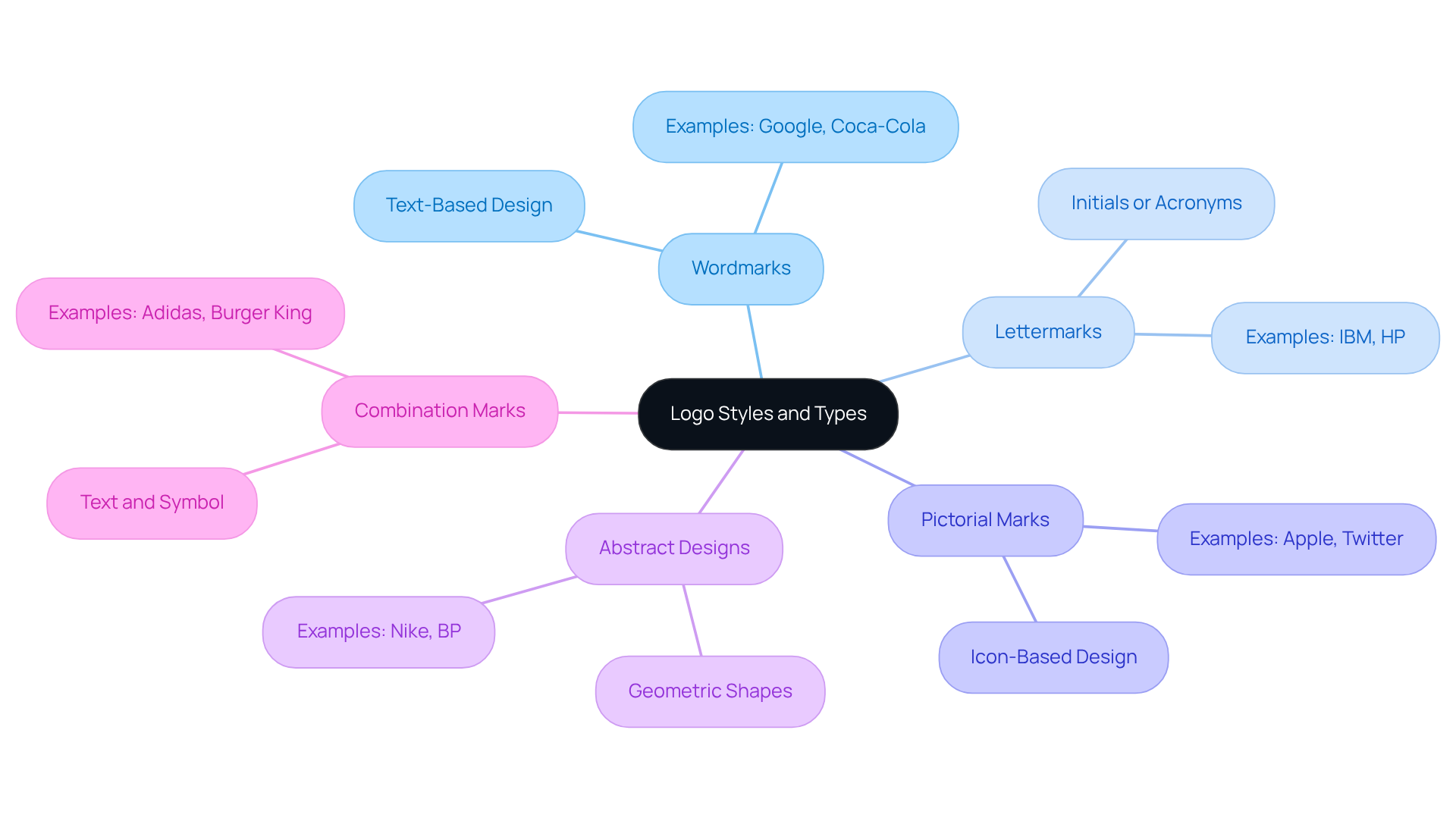
Select Colors and Typography
Selecting a color palette that truly reflects your company's personality is vital for crafting a strong identity. At RNO1, we understand that every design decision should resonate with a commitment to impactful logo and brand design. Have you ever considered how color psychology can reveal the emotions different hues evoke? For example, blue often symbolizes trust and reliability, while red can spark excitement and urgency. It’s important to recognize that colors alone can shape up to 90% of an initial impression, making your color choices even more significant. To maintain clarity and impact, we encourage you to limit your palette to 2-3 primary colors, ensuring they work harmoniously together. This thoughtful approach can , particularly in terms of logo and brand design, by as much as 80%.
When it comes to typography, selecting fonts that enhance your brand's style is crucial. A combination of a bold typeface for your logo and a simpler font for accompanying text can create a balanced look that feels right. Prioritizing legibility is essential, as is ensuring that the chosen fonts align with your company's tone—be it modern, playful, or professional. Consistency in marketing is key for establishing a recognizable and relatable identity across various channels. At RNO1, we recognize that effective typography can significantly improve identity recognition, as 85% of consumers’ choices are influenced by color, and 93% of consumers make purchasing decisions based on visuals alone. By thoughtfully choosing colors and typography, you can profoundly impact how your logo and brand design are perceived in the competitive tech landscape, enhancing your marketability through our Return On Design & Digital (RODD) strategies.
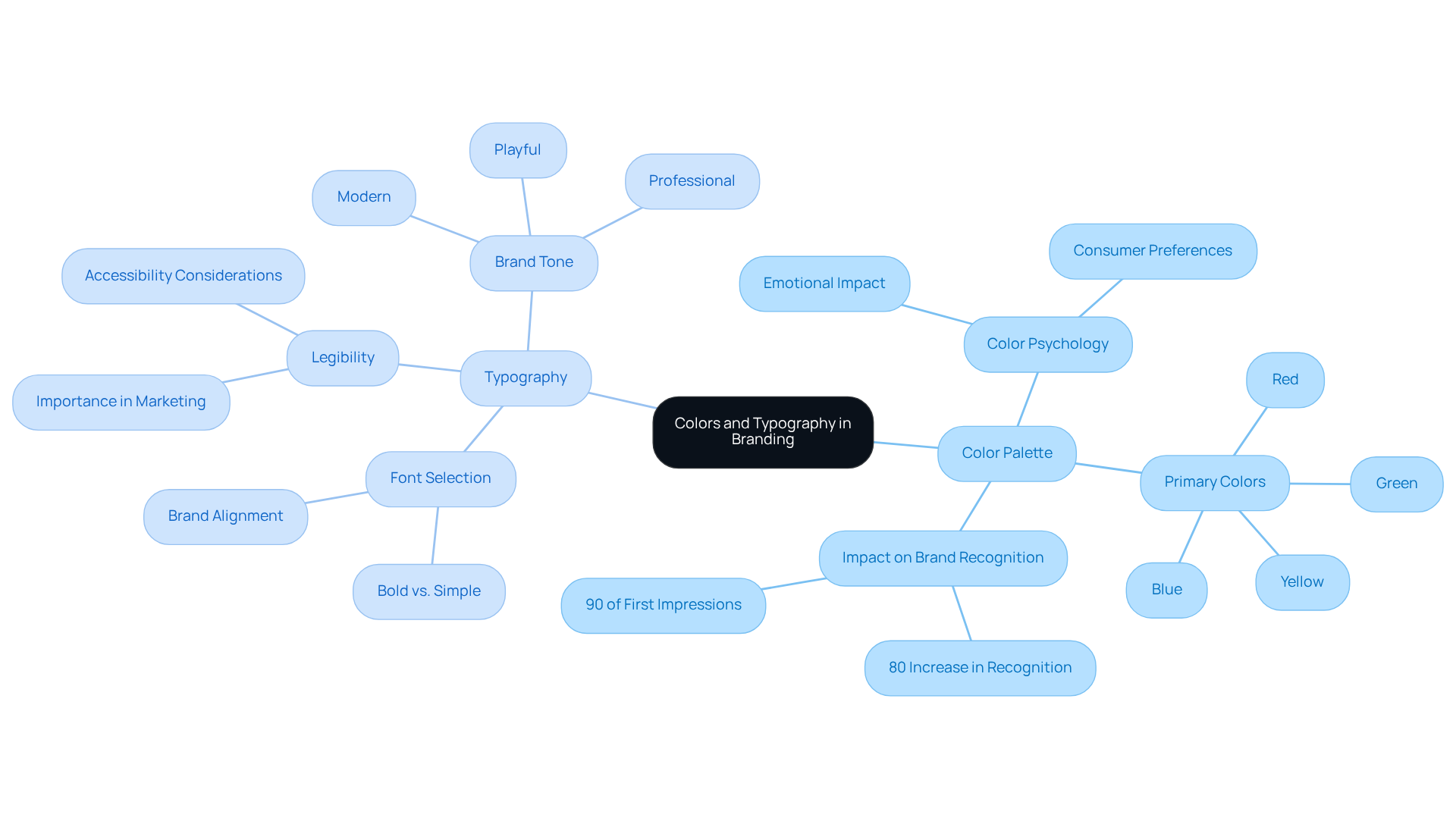
Refine Your Logo and Prepare for Launch
Creating design concepts can feel overwhelming, especially when seeking feedback from stakeholders and potential customers. It’s crucial to understand their perspectives—consider utilizing surveys or focus groups to gauge their reactions. Focus on clarity, appeal, and alignment with your logo and brand design. By modifying your emblem based on this feedback, you ensure it truly resonates with your audience.
Versatility is key; your brand symbol should be across various sizes and formats, from business cards to digital platforms. In fact, 67% of consumers prefer symbols that showcase clean and simple designs, underscoring the importance of simplicity and adaptability. To maintain quality across all platforms, prepare high-resolution files for both print and digital use. Companies that uphold a consistent brand image across channels typically see a 23% increase in customer loyalty.
Moreover, developing an extensive style guide is essential. This guide should outline the uniform usage of your emblem, color scheme, and typography across all marketing platforms. Consistency is vital, as 75% of consumers identify a company by its emblem. This highlights the significance of a well-executed logo and brand design in nurturing customer loyalty. Remember, logo and brand design are crucial for brand recognition, trust, and customer loyalty, as they represent the first visual point of contact with consumers. Embrace this journey with confidence, knowing that thoughtful design can create lasting connections.
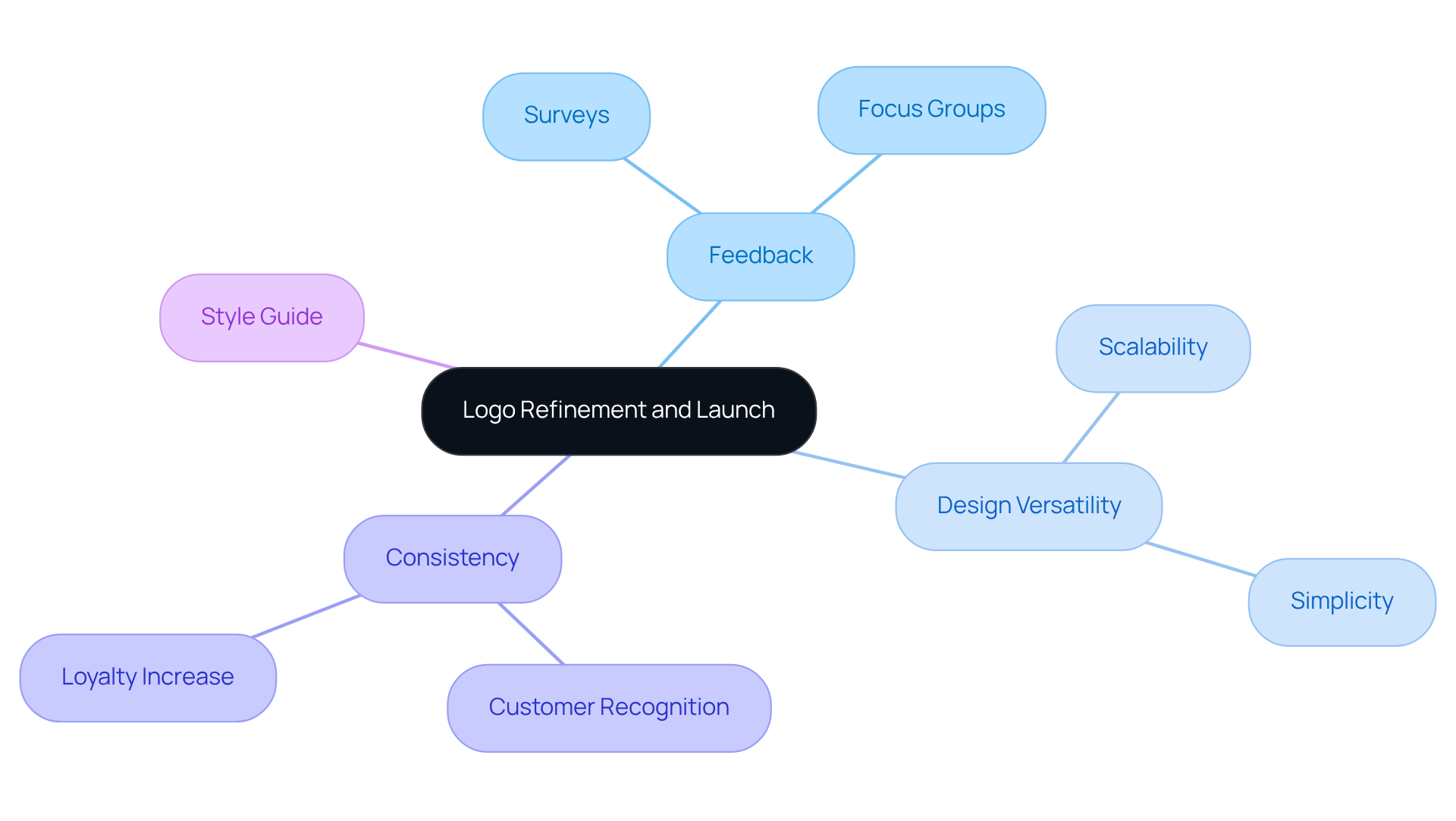
Conclusion
Mastering logo and brand design is a vital journey for startups, as it lays the groundwork for a strong market presence and meaningful connections with consumers. Startups often grapple with defining their brand identity, seeking inspiration, selecting appropriate styles, and refining their designs. This process can feel overwhelming, yet it is essential for creating a visual representation that resonates with their mission and values. By embracing this journey, startups can enhance recognition and foster loyalty and trust among potential customers.
In this guide, we’ve outlined key steps to help navigate the complexities of logo and brand design:
- Establish a clear brand persona.
- Explore diverse sources of inspiration.
- Choose the right colors and typography.
- Refine the logo based on feedback.
- Ensure consistency across all platforms.
Each element plays a significant role in shaping the brand's overall impact. Choosing the right colors and typography is not merely a design choice; it’s about conveying the essence of the brand. Moreover, refining the logo based on feedback and ensuring consistency across all platforms are crucial steps in reinforcing brand identity and enhancing consumer trust.
As we conclude, the importance of a well-executed logo and brand design cannot be overstated. We encourage startups to embrace this creative process with confidence and intentionality. By prioritizing thoughtful design and engaging with their audience, they can cultivate a brand that not only stands out in a competitive landscape but also resonates deeply with their target market. Taking these steps will elevate their brand and pave the way for long-term success and loyalty in an ever-evolving business environment. Remember, you are not alone on this journey; with each thoughtful decision, you are building a community around your brand.
Frequently Asked Questions
What is brand identity, and why is it important?
Brand identity is the persona that embodies a business's mission, values, and target audience. It is essential because it guides all creative decisions and helps establish a strong market presence.
How can I define my brand identity?
To define your brand identity, consider your mission, values, and target audience. Conduct surveys or interviews with potential customers to gather insights into their perceptions and expectations.
What role does a logo style manual play in brand identity?
A logo style manual is crucial for influencing the logo design process and ensuring consistency in branding. It is developed based on the insights gathered about your brand identity.
What statistics highlight the importance of a clearly defined corporate persona?
While 95% of companies have guidelines for their image, only 25% actively implement them. Startups that clarify their image before launching are more likely to establish a strong market presence.
How can effective marketing impact revenue?
Effective marketing can boost revenue by 10-20%, making it a significant incentive for founders to focus on brand identity and marketing strategies.
What sources of inspiration can tech startup founders explore for design projects?
Tech startup founders can explore creative websites, social media platforms like Pinterest and Instagram, and the beauty of nature or architecture for design inspiration.
What is a mood board, and how does it help in the design process?
A mood board is a visual collection that enhances communication and clarifies project objectives. It incorporates colors, fonts, and symbols that resonate with the brand identity, helping to establish a solid design foundation.
How can brainstorming sessions benefit the creative process?
Brainstorming sessions foster a nurturing environment for idea generation without judgment. Techniques like mind mapping or sketching can help visualize concepts and stimulate creativity.
What is the significance of inclusivity and diversity in design elements?
Research indicates that 70% of consumers prefer symbols that represent inclusivity and diversity, making it essential to choose design elements thoughtfully.
How does sharing the mood board process strengthen client relationships?
Sharing the mood board process aligns expectations and enhances trust, inviting collaboration and connection, and creating a supportive community around the vision.




